Premier League football is back, and fans can now look forward to seeing their favourite teams back in action. Most teams in the league will find that these final game weeks are very important, for varying reasons. Liverpool are looking to wrap up their first league title in 30 years. Aston Villa and Bournemouth are hoping to get some results to get them out of the bottom three, while Watford, West Ham United, and Brighton will be aspiring to remain above the relegation zone. The fight for European football for next season continues as well. Tottenham Hotspur and Arsenal, currently in 8th, and 9th respectively, face the prospect of no European football at all next season. However, the gap in points is not huge, and these final game weeks are so important.
Another club whose fate lies in how they perform when the league returns is Manchester United. They currently sit in 5th place, with 45 points out of a possible 87. As of right now, they do qualify for a UEFA Champions League spot next season, solely because Manchester City were banned from all UEFA club competitions for the 2020–21 and 2021–22 seasons by the UEFA Club Financial Control Body due to violations of the UEFA Financial Fair Play Regulations (FFP). City did appeal to the Court of Arbitration for Sports (CAS) earlier this week, and a decision is pending. What this means, is that should Manchester City win the appeal, and Manchester United remain in 5th at the end of the season, they will be competing in the Europa League again next season. Furthermore, even if Manchester City do not win the appeal, Tottenham are only four points behind United, and Arsenal are five points behind. Those gaps can easily be closed by the two North London clubs. There’s a lot riding on the line for Manchester United in these upcoming weeks. Champions League football next season means more revenue, and more attraction to big-name signings they might want to make, and this tactical analysis will focus specifically on the tactics they need to employ to better their chances in guaranteeing a spot in the Champions League.
How United should line-up
Ole Gunnar Solskjær has predominantly used the 4-2-3-1 this season, using it in 69% of United’s matches this season.
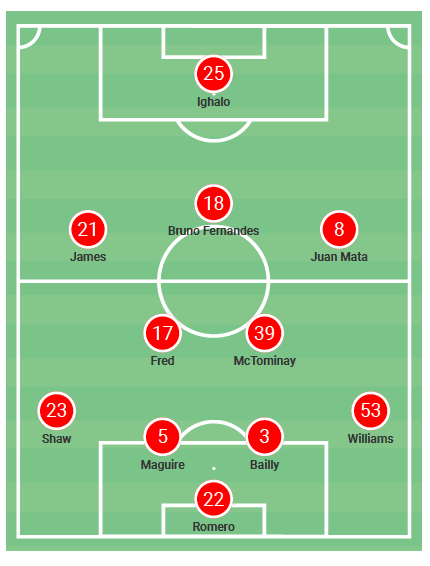
For the bigger matches, against the ‘top six’, Solskjær prefers the 3-4-1-2, using it against the likes of Manchester City and Liverpool. There is no indication that Solskjær will stray from these the two formations when the season restarts.
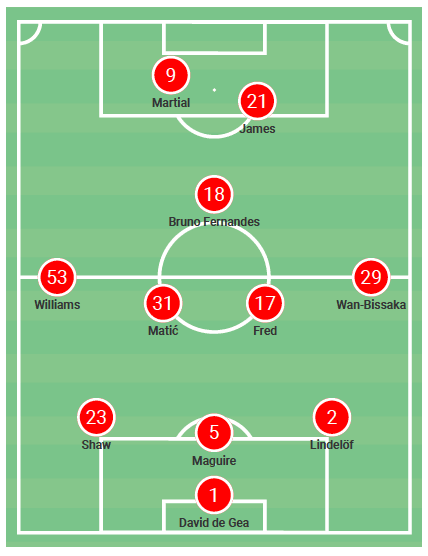
United were in good form before the season halt, which may have been frustrating, as they were not allowed to continue the strong momentum that they had. However, the break has allowed a few key players to return. I expect that they’ll likely lineup like this.
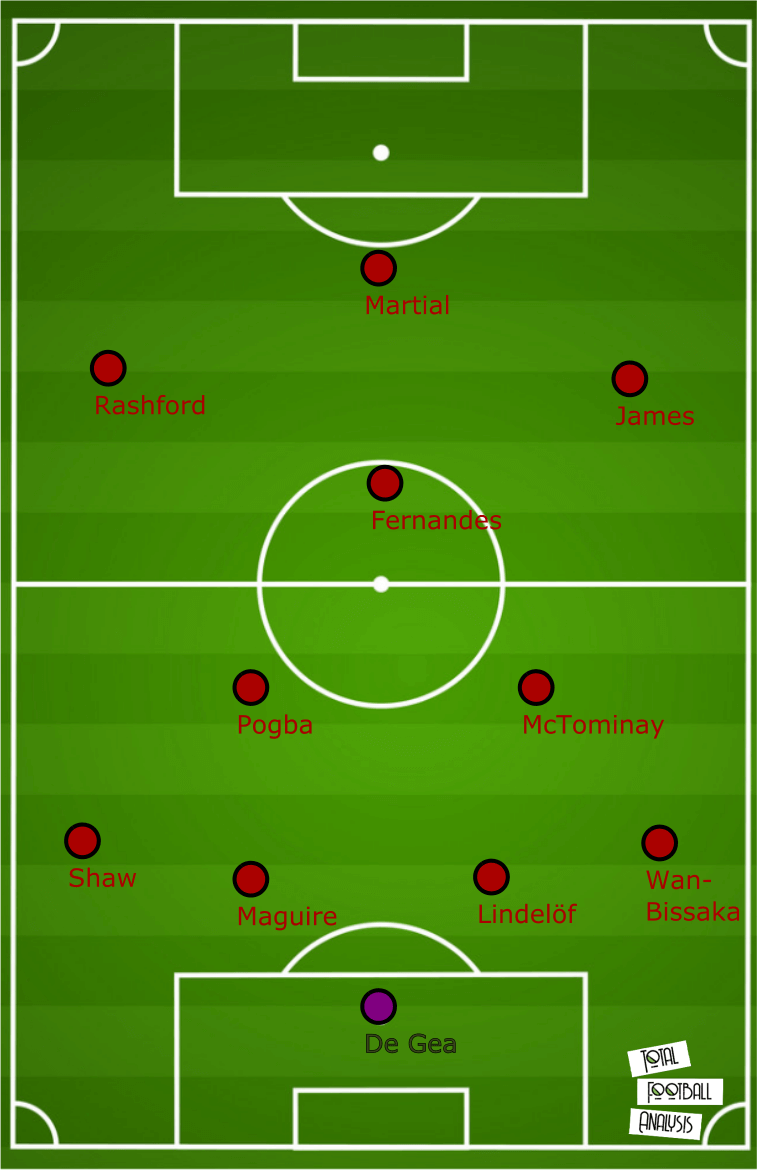
This analysis will look at this lineup, focusing on the defence, midfield, and attack in depth by analyzing how they have performed so far this season, and what tactics they need to deploy to ensure they win as many points as possible tactics wise.
Defensive Stability
A few of those players in the line-up are automatic starters. In the defensive line, David De Gea, Aaron Wan-Bissaka, Harry Maguire are all players who Solskjær will trust, as he has throughout the season. Wan-Bissaka signed from Crystal Palace last summer, and he’s already become a fan favourite at the club, his exceptional tackling and ball interception skills being the highlight of his tenure so far. When comparing him to other full-backs in the league, Wan-Bissaka is top of the list for successful defensive actions per 90 (for players who have played over 500 minutes) at 13.25. He also tops the list for sliding tackles per 90 at 2.08.
What is even more impressive are his Possession Adjustided statistics (PAdj statistics). PAdj is a way to calculate defensive statics while taking the team’s possession values into account. Defensive statistics can sometimes be skewed because more often than not, one team will have more possession of the ball, then the other; it is never 50%/50%. A player can only make a defensive play if his team does not have possession of the ball. This is why we’ll often see defenders of the lower teams in the league have higher defensive values because they are defending more, against possession-based sides (usually the better teams in the league). PAdj statics are statistics that are adjusted to be calculated as if the match was played with both teams having 50% possession. Wan-Bissaka leads the league in PAdj sliding tackles at 2.83 per 90, and PAdj interceptions at 10.56 per 90. Manchester United’s backline has become much stronger with him in it.
Harry Maguire was another one of United’s 2019 summer signings that was needed to strengthen their defence. He has had some struggles, especially in the first half of the season, but overall, he has elevated United to be a better side defensively. The main attribute that he brings to this team that was desperately needed was his aerial ability while out of possession. This season in the league, Maguire has won 73.2% aerial duels, the most out of any Manchester United player, with Victor Lindelöf in second (60.4%). Last season, United’s top two players when it came to aerial duels were Chris Smalling and Romelu Lukaku. Not only are both those players not at the club anymore, but the reason United still had issues with winning aerial duels in their own box was down to Smalling not committing to as many as Maguire does. Smalling had a higher win percentage at 73.8%, but he attempted far fewer headers, only winning 90 in a full season versus Maguire who has won 150 so far. Maguire is also a threat aerially when in possession, with United becoming much more dangerous from set-pieces, and dead balls. Maguire’s aggressiveness has not only benefited United when it has come down to aerial duels.
Unlike Smalling, he is a much better ball-playing centre-back. This benefits United because his clearances, and long balls, are more accurate, resulting in started counter-attacks. It also allows him to move up the pitch with the ball at his feet, which in turn allows the attackers to be further up the bitch. They do not have to worry about coming in, and picking up the ball from deep in their own half.
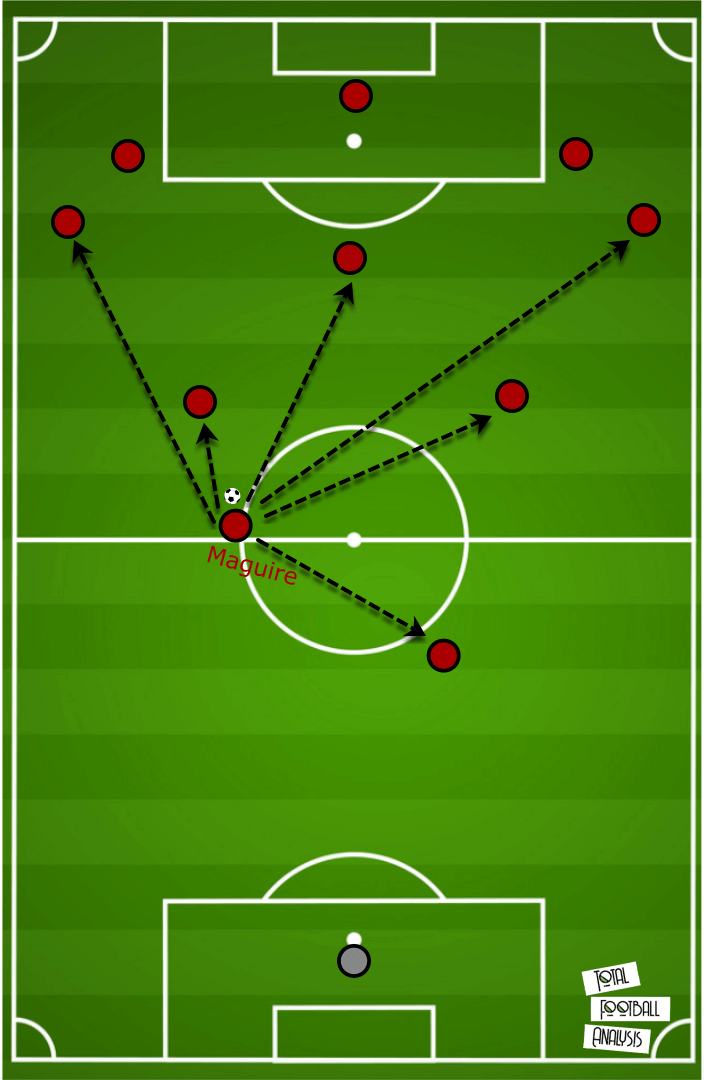
The question now becomes which other two players line up alongside De Gea, Wan-Bissaka, and Maguire when United field their best XI. For who pairs up with Maguire, Solskjær has to choose between Lindelöf and Eric Bailly. I’ve put Lindelöf in the team over Bailly simply because Bailly has only played a total of 102 minutes in the league due to injury, and Lindelöf and Maguire have played together for most of the season. The good news for Solskjær is that both players compliment Maguire quite well. Both are not the strongest at aerial duels, but in turn, excel at ground duels, controlling the ball, and covering attackers whilst they run in behind.
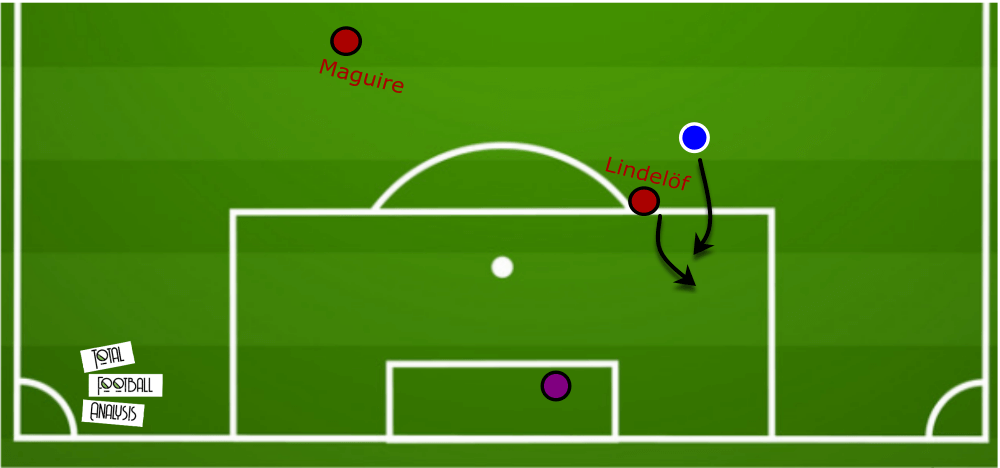
While Maguire is better on the ball, both Bailly and Lindelöf can hold their own as well.
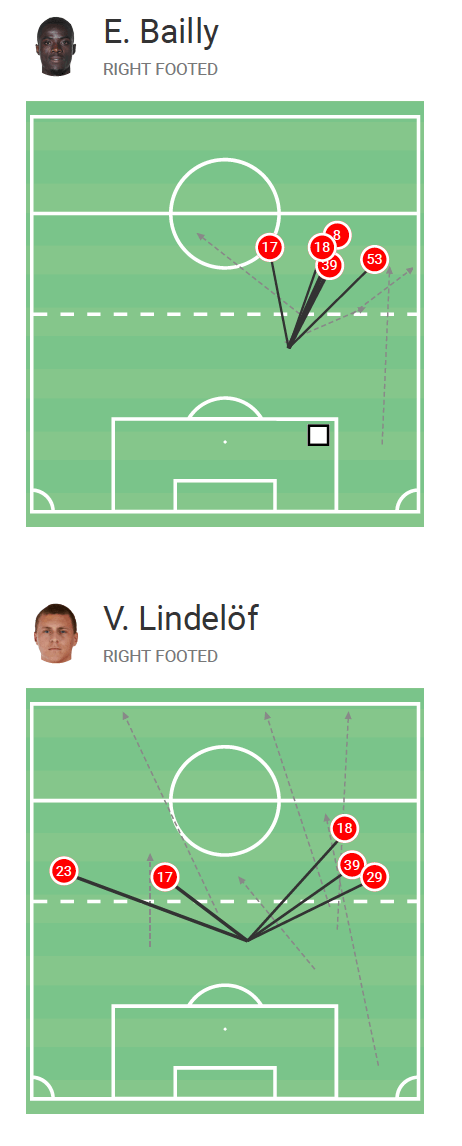
For the left-back position, Solskjær has three options in Luke Shaw, Diogo Dalot, and Brandon Williams. Williams is a player who comes from Manchester United’s academy, having just joined the first team this season. While he has lots of potential, I don’t expect Solskjær to trust him fully yet in this very important run of games. While I do expect him to get minutes, he likely will not be United’s starting left-back.
This leaves Shaw and Dalot. I placed Shaw in the lineup because I do think he’s performed at a very high level this season, quite consistently. That being said, I think Solskjær uses Shaw or Dalot based on the tactics he wants to employ against teams.
Luke Shaw’s skill set is much better if Solskjær wants to implement a system with inverted full-backs in attack. Pep Guardiola often uses this tactic with one or both of his fullbacks at Manchester City. This is an advantageous tactic for a few reasons. First, it allows the full-backs to occupy more central positions whilst their team has the ball, making them more narrow, and more likely to retain ball retention, with shorter, more accurate passes. Second, their central position also allows the central midfielders to be part of the front five allow them to occupy the half-spaces in between the opposition’s centre-back, and the opposition’s fullback, making it difficult to defend against.

Dalot’s skillset suits Solskjær is he wants his fullbacks to be more traditional in providing width during the attack. Dalot is good at keeping the width and stretching the opposition’s defence to create gaps for his teammates to exploit.
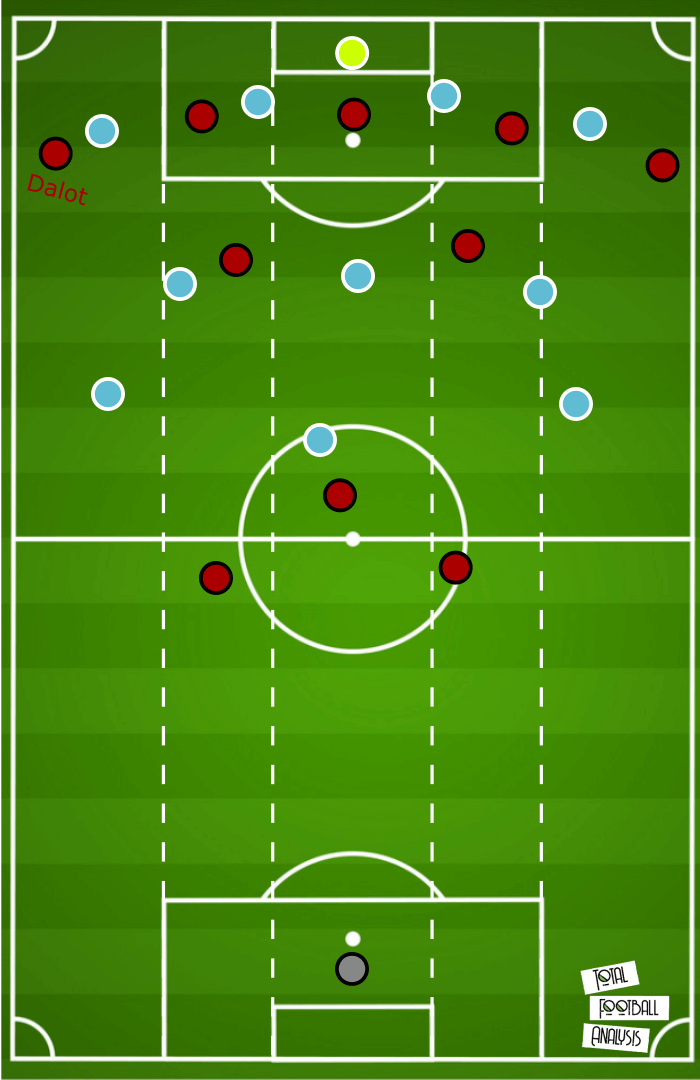
Let’s look at the statistics that show why each player is better suited to the specific tactic. Shaw is much more disciplined than Dalot. He has the capabilities to fulfil that inverted role, without straying, or bombing forward like the modern fullback currently does. Dalot is a better, and more confident crosser, completing an average of 4.29 per match compared to Shaw’s 1.82, while Shaw has less intercepted passes with 1.08 to Dalot’s 2.86 – the less interceptions a player has towards their own goal, the better, as it gives the opposition less of a chance to counterattack. Shaw is also better the air, winning 23 aerial duels compared to Dalot’s four meaning he’s much better equipped on handling balls over the top when the opposition try to clear it. Finally, Dalot is a much better option to be the fullback closer to attacking play, as he averages more key passes per 90, more passes to the penalty area per 90, and more progressive passes per 90.
Midfield Balance
The midfield is probably the most exciting prospect for Manchester United fans, as it will be the first time Paul Pogba and Bruno Fernandes will be playing together. When Fernandes first signed in the January transfer window, Pogba was out injured with ankle issues. He’s seemingly recovered, and both players are considered two of United’s best players. The question now becomes, can they play alongside each other?
Short answer: Yes, because Solskjær will deploy them in different positions. Before Pogba was injured, he was playing as a double pivot, a #8 role, alongside another central midfielder, either Fred, Scott McTominay or Nemanja Matić. Since he’s come in, Fernandes has played in the #10 role, which was previously occupied by one of Jesse Lingard or Andreas Pereira.
Before Pogba was injured, he was the main dynamic creator for United. Last season in the league, he led the team in passes that lead to a shot attempt (108), successful dribbles that lead to a shot attempt (9), shots that lead to another shot attempt (13), fouls drawn that lead to a shot attempt (11), goal creating actions (18), passes that lead to a goal (13), goals (13), and assists (9). Safe to say he was doing a lot of the heavy lifting offensively.
The main problem was that Pogba often was responsible for starting the attack when United won possession in their own half, and finishing off the chance, by either completing the final pass or taking a shot. He was essentially playing as the #6, #8, and the #10, all at once. That’s a lot of responsibility for one player. This is where Fernandes comes in. Pogba can now focus on starting play from the central midfield position, while Fernandes can remain higher up the pitch and dictate play from the final third.
The massive advantage of having them play together, outside of the fact that it allows Pogba to do less of the heavy lifting, it that they’ll be incredibly hard to defend against, simply because they like to operate in the same way: by finding space. In previous matches against Manchester United, opposition teams could man-mark Pogba, and/or limit the space he tried to run into. With two players, who are constantly moving off the ball looking for this space, this becomes much more difficult.
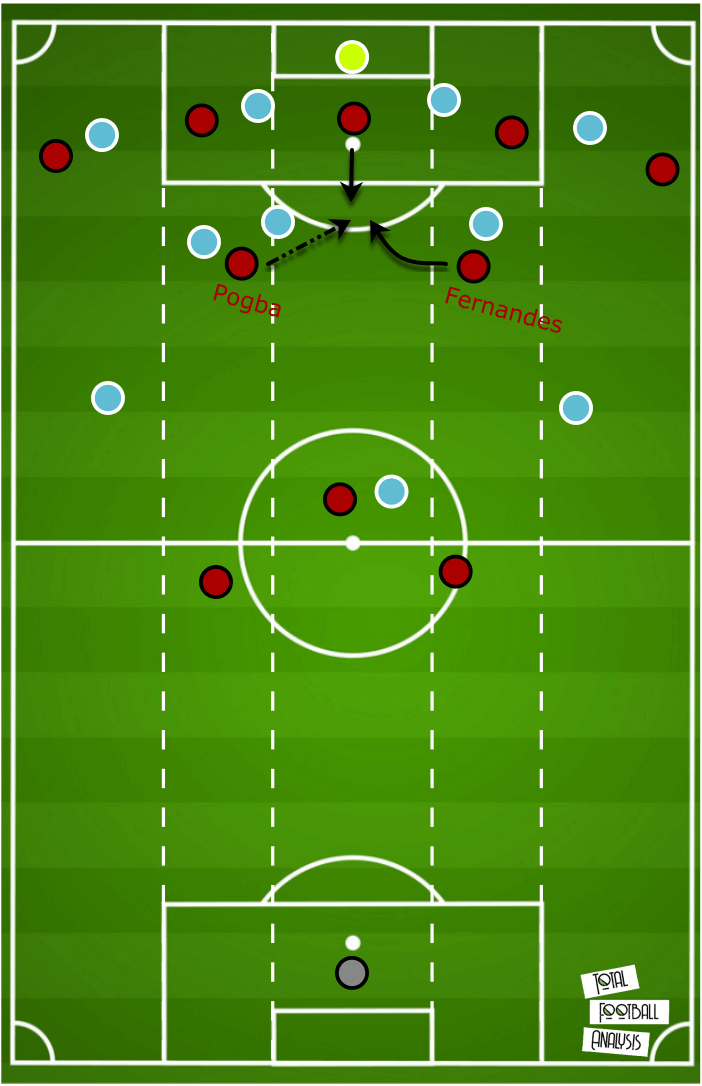
The final question then becomes who the third midfielder to play alongside Pogba and Fernandes. Because of Pogba and Fernandes’ output ging forward, the midfield needs to be balanced, and thus, the final midfielder has to be more defensive-minded. One of Fred, McTominay, and Matić will likely be the third midfielder if Pogba and Fernandes are in the same starting XI. Matić, as good and successful as he has been during his career, at 31 years old, he does not have the legs and the stamina anymore to cover, and be a reliable player acting as the last midfielder before the defensive line.
McTominay starts for me over Fred for two reasons. The first being that before Pogba’s injury, he had a formidable partnership with McTominay, where they excelled in the double pivot. Secondly, and more importantly, McTominay is more dynamic, versatile, and has better positioning. While Fred is more of the ‘destroyer’, McTominay has the ability to swap positions with Pogba, and even Fernandes if need be. This tactic can confuse opposition players whilst defending, allowing them to make errors, which United can then exploit.

Look out for an in-depth analysis piece next week that explores more on how Pogba and Fernandes will play together on Total Football Analysis by Harshal.
Attacking Play
Manchester United’s current front three of Marcus Rashford, Anthony Martial, and Daniel James are likely to be the starting three week in, week out. United’s problem this season has mainly been scoring goals and United need to win matches to secure a Champions League spot, obviously. It is just too risky to utilize someone like Mason Greenwood, a talented, but inexperienced, and inconsistent player during this run in.
Rashford and Martial were combining well together to create a formidable lopsided front two before Rashford’s injury, with Martial as a pure #9 and Rashford acting as a wide forward. This combination is a huge relief for United fans, as it has been a couple of seasons now where there has been a constant debate of whether Rashford excels in the middle or on the wing. He’s finally seemed to find a position that suits him, and that he’s comfortable playing in. The two, along with James and Fernandes/Pogba behind them have a chance to really excel in devastating teams.
As mentioned, United have struggled at times to score this season. Fernandes has definitely helped in that department, but a part of the problem is rash decision making. A lot of times, the player with the ball seems to have already made up their mind as to what play they are going to make. James specifically struggles with this, and he’ll often find himself in a great position to pass the ball forward when his teammate has space, but instead, he’ll go for the shot, or pass the ball backwards, ruining the chance. The predictability of it makes Manchester United’s attacking play a bit one-note, especially when teams succeeded at man-marking Pogba. The XI with both the Frenchman and Fernandes should hopefully eliminate the predictability.
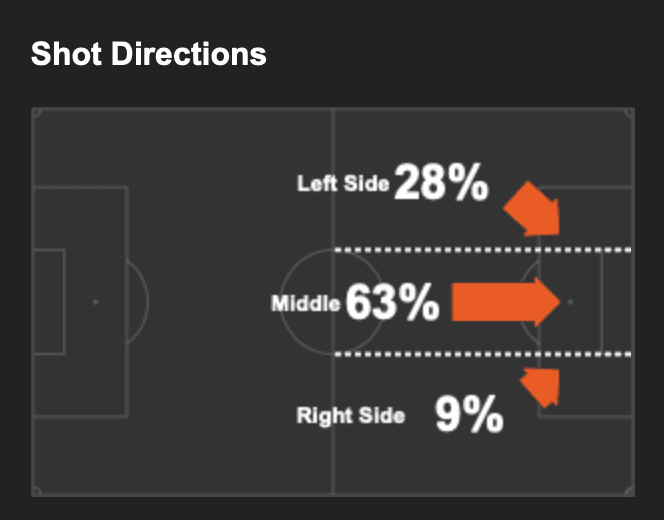
Final Thoughts
Manchester United have nine matches remaining, and in an ideal world, they would be able to win all nine, or at least gain points from all nine matches this season. Pretty unrealistic though, as the team has not won more than two matches in a row in the league season, their longest unbeaten run being six games (three wins and three draws).
What United need to do is focus on taking points of the teams above them, and the teams below them who are competing for European football. The hope is then that United can also take enough points off of the lower league teams, while simultaneously their opposition that are competing for the Champions League drop points against other teams.
United’s nine fixtures include matches against Spurs, Sheffield United, and Leicester City. These are the three crucial matches in my opinion. Sheffield United and Leicester City are above Man United in the table, and Spurs are a few points below them and the club that will most want/are most capable of getting into the Champions League. The XI that Manchester United need to deploy is described in the above scout report, as long as the tactics behind it. It is a balanced team, that gives United the best opportunity to create chances while still saying defensively compact.






Comments